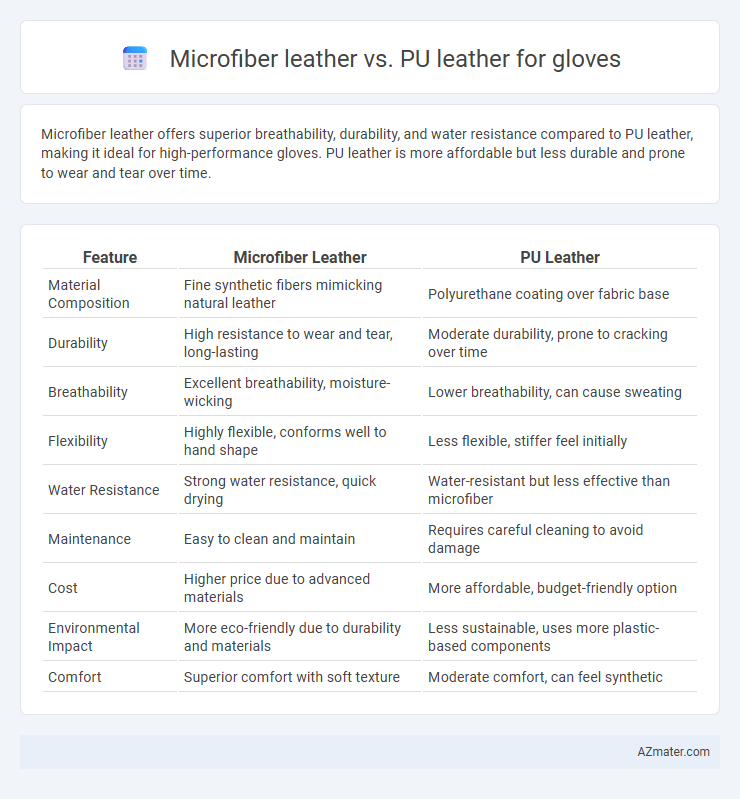Microfiber leather offers superior breathability, durability, and water resistance compared to PU leather, making it ideal for high-performance gloves. PU leather is more affordable but less durable and prone to wear and tear over time.
Table of Comparison
| Feature | Microfiber Leather | PU Leather |
|---|---|---|
| Material Composition | Fine synthetic fibers mimicking natural leather | Polyurethane coating over fabric base |
| Durability | High resistance to wear and tear, long-lasting | Moderate durability, prone to cracking over time |
| Breathability | Excellent breathability, moisture-wicking | Lower breathability, can cause sweating |
| Flexibility | Highly flexible, conforms well to hand shape | Less flexible, stiffer feel initially |
| Water Resistance | Strong water resistance, quick drying | Water-resistant but less effective than microfiber |
| Maintenance | Easy to clean and maintain | Requires careful cleaning to avoid damage |
| Cost | Higher price due to advanced materials | More affordable, budget-friendly option |
| Environmental Impact | More eco-friendly due to durability and materials | Less sustainable, uses more plastic-based components |
| Comfort | Superior comfort with soft texture | Moderate comfort, can feel synthetic |
Introduction to Microfiber Leather and PU Leather
Microfiber leather for gloves is a synthetic material made from ultra-fine fibers, offering enhanced durability, breathability, and a soft, natural leather feel. PU leather, or polyurethane leather, is a synthetic leather substitute created by coating a fabric base with a flexible polyurethane layer, known for its affordability and water resistance. Both materials serve as popular alternatives to genuine leather, with microfiber leather often praised for superior strength and comfort compared to PU leather.
Composition and Manufacturing Processes
Microfiber leather gloves are crafted from ultra-fine synthetic fibers woven tightly to mimic natural leather's texture and durability, offering enhanced breathability and flexibility. PU leather gloves are produced by coating a fabric base, typically polyester or cotton, with a polyurethane layer that provides a smooth, leather-like finish while being less breathable and less resistant to wear. The manufacturing process for microfiber leather involves microfiber spinning and weaving, followed by finishing treatments, whereas PU leather relies on polymer coating and embossing techniques to achieve its look and feel.
Durability and Longevity Comparison
Microfiber leather offers superior durability compared to PU leather due to its dense fiber structure, which resists wear and tear more effectively. The longevity of microfiber leather gloves is typically greater, maintaining their flexibility and appearance after extended use and repeated flexing. In contrast, PU leather gloves may degrade faster, showing signs of cracking and peeling under heavy or prolonged use.
Comfort and Flexibility for Gloves
Microfiber leather offers superior comfort and flexibility for gloves due to its breathable structure and soft texture, closely mimicking natural leather. PU leather, while cost-effective and water-resistant, tends to be less breathable and less flexible, which can lead to reduced comfort during extended wear. Choosing microfiber leather enhances dexterity and provides a more comfortable, glove-like fit essential for precision tasks.
Breathability and Moisture Management
Microfiber leather offers superior breathability compared to PU leather, enabling better air circulation and reducing sweat buildup inside gloves. Its structure promotes efficient moisture management by wicking away perspiration, keeping hands dry and comfortable during extended use. PU leather, while durable, tends to trap heat and moisture, making it less effective for gloves requiring high levels of ventilation and moisture control.
Appearance and Aesthetic Quality
Microfiber leather offers a more natural and luxurious appearance compared to PU leather, featuring a finer grain texture that closely mimics genuine leather. Its enhanced breathability and softness contribute to a high-end aesthetic ideal for premium gloves. PU leather often appears shinier and less textured, which can result in a less authentic look and a lower perceived quality in glove design.
Environmental Impact and Sustainability
Microfiber leather, made from finely woven synthetic fibers, offers enhanced durability and biodegradability compared to traditional PU leather, which relies heavily on polyurethane coatings derived from fossil fuels. The production of microfiber leather typically consumes less water and emits fewer volatile organic compounds (VOCs), reducing its overall environmental footprint. Choosing microfiber leather gloves supports sustainability efforts through longer product lifespan and greater potential for recycling and waste reduction.
Cost Differences and Value for Money
Microfiber leather gloves generally cost more than PU leather gloves due to superior material durability and breathability, providing enhanced comfort and longer lifespan. PU leather gloves offer a more affordable option with decent water resistance but tend to wear out faster, leading to higher replacement frequency. Consumers seeking the best value for money prioritize microfiber leather for its cost-effectiveness over time despite higher upfront investment.
Common Uses in Glove Manufacturing
Microfiber leather in glove manufacturing is preferred for its durability, breathability, and natural leather-like texture, making it ideal for high-performance sports and work gloves. PU leather offers a cost-effective and water-resistant alternative, commonly used in fashion and driving gloves where flexibility and style are prioritized. Both materials provide synthetic options that cater to specific user needs in protective and casual glove applications.
Final Verdict: Which Material is Better for Gloves?
Microfiber leather offers superior breathability, durability, and flexibility compared to PU leather, making it ideal for high-performance gloves requiring comfort and longevity. PU leather, while more affordable and water-resistant, tends to wear out faster and lacks the natural feel of microfiber. For gloves demanding enhanced durability and comfort, microfiber leather is the better material choice.

Infographic: Microfiber leather vs PU leather for Glove
 azmater.com
azmater.com